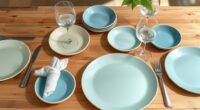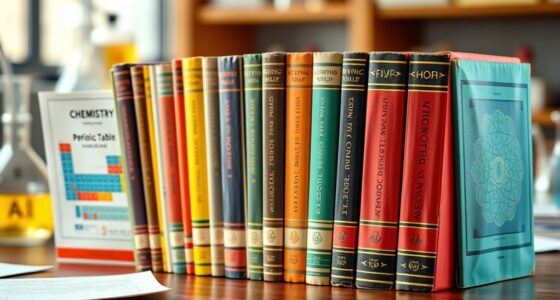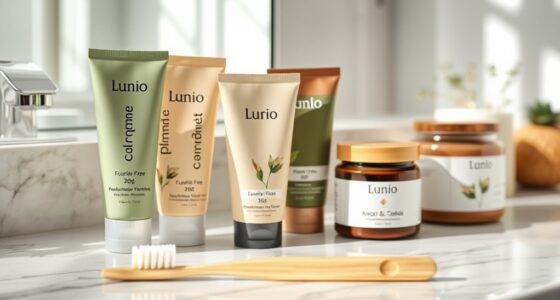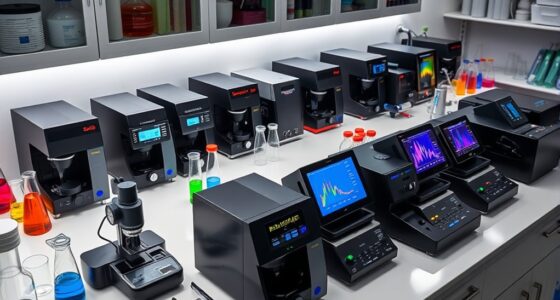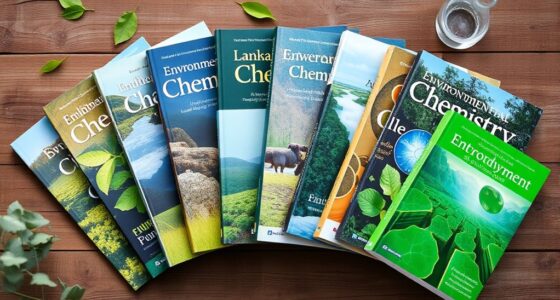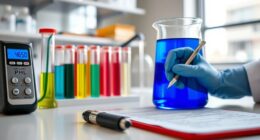If you’re looking for the best biology and chemistry crossover kits for young scientists, I recommend checking out options like the National Geographic Kids Junior Chemistry Set and Thames & Kosmos Ooze Labs Chemistry Station for beginners. For more advanced exploration, the RELIANCER Molecular Model Kit and Thames & Kosmos Genetics & DNA Lab offer deeper hands-on experiences. You’ll find a mix of fun experiments, detailed models, and educational value. Keep exploring to discover the perfect fit for your budding scientist.
Key Takeaways
- Look for kits combining molecular modeling, biological specimens, and chemistry experiments to promote interdisciplinary learning for young scientists.
- Prioritize sets with durable, high-quality materials and clear instructions to ensure safe, engaging exploration across biology and chemistry.
- Choose age-appropriate kits that include visual tools like models and microscopes to enhance comprehension of complex scientific concepts.
- Consider kits recognized for safety standards, educational value, and positive reviews from experts or awards like Parents’ Choice.
- Opt for comprehensive kits offering a variety of experiments, from DNA models to chemical reactions, fostering curiosity in both biology and chemistry.
National Geographic Kids Junior Chemistry Set for Early Learning
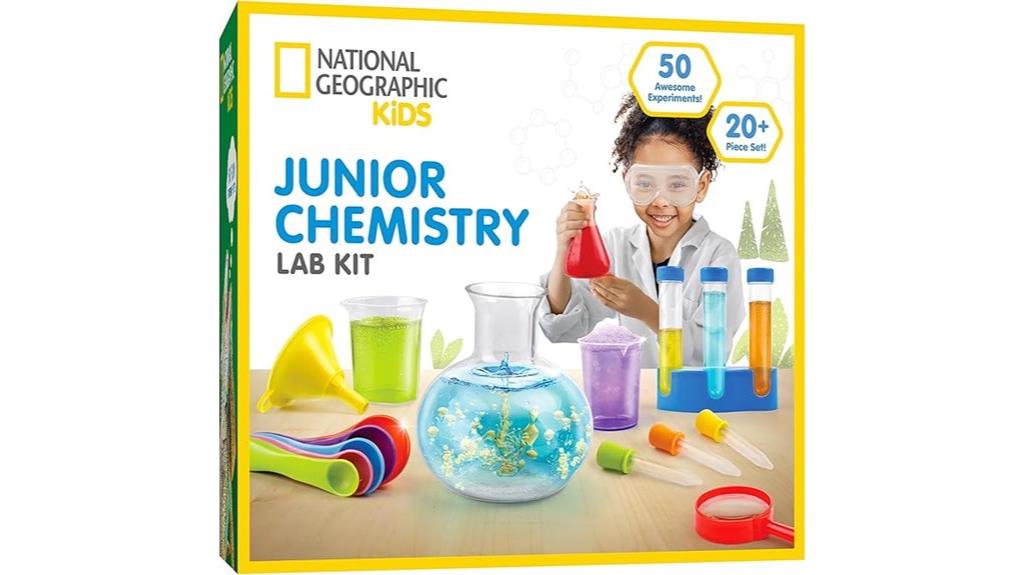
If you’re looking for an engaging way to introduce young children to science, the National Geographic Kids Junior Chemistry Set is an excellent choice for kids aged 4 to 6. I love how it offers a complete early learning lab experience, sparking curiosity through hands-on experiments. With 50 activities using common household items like baking soda and vinegar, kids get to explore basic chemistry concepts safely. The kit includes over 20 child-safe tools and illustrated instructions, making it easy for little scientists to succeed. Parents appreciate its durability, safety, and educational value, making it a fantastic gift that nurtures early scientific skills and love for discovery.
Best For: young children aged 4 to 6 who are curious about science and enjoy hands-on learning experiences.
Pros:
- Provides 50 engaging experiments using household items, fostering curiosity and basic chemistry understanding.
- Includes over 20 durable, child-safe tools with illustrated, easy-to-follow instructions.
- Made from high-quality materials, ensuring safety, durability, and easy cleaning for repeated use.
Cons:
- Some experiments may not work as expected or can be challenging for very young children.
- A few users report missing tools or minor issues with certain activities.
- The experiment book could offer more detailed cause-and-effect explanations to enhance learning.
Thames & Kosmos Ooze Labs Chemistry Station Science Kit
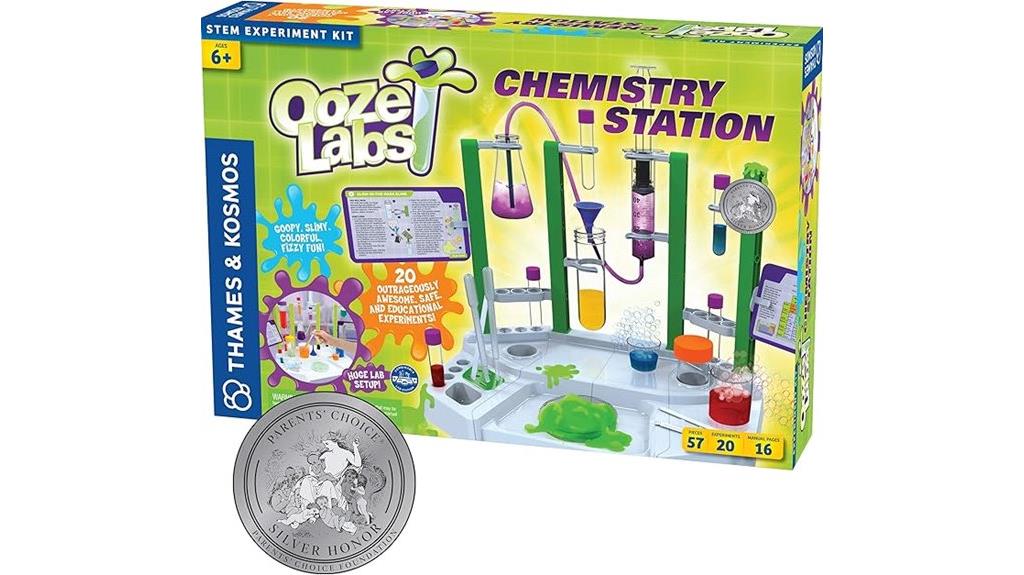
The Thames & Kosmos Ooze Labs Chemistry Station Science Kit is an excellent choice for children aged 6 and up who are enthusiastic to explore chemistry through hands-on experiments. It features a colorful, large lab setup with 57 pieces, including beakers, test tubes, and syringes, making it easy for kids to perform safe, real experiments. With printed experiment cards and a detailed manual, children can create glowing slime, underwater volcanoes, and perform pH tests. The kit emphasizes safety with non-hazardous chemicals and is designed to be engaging and educational. It’s perfect for sparking curiosity and fostering early scientific exploration at home or in the classroom.
Best For: young children aged 6 and up who are eager to explore chemistry through safe, hands-on experiments that are engaging and educational.
Pros:
- Includes 57 durable pieces for a variety of fun, safe experiments.
- Comes with printed experiment cards and a detailed manual for easy guidance.
- Emphasizes safety with non-hazardous chemicals and does not contain borax.
Cons:
- Some experiments may require additional household materials like foil or common grocery items.
- May need adult supervision for messier or more complex activities.
- The set’s size and weight (around 1 pound) might limit portability for travel.
Thames & Kosmos Genetics & DNA Lab 10×2.5×11 inch
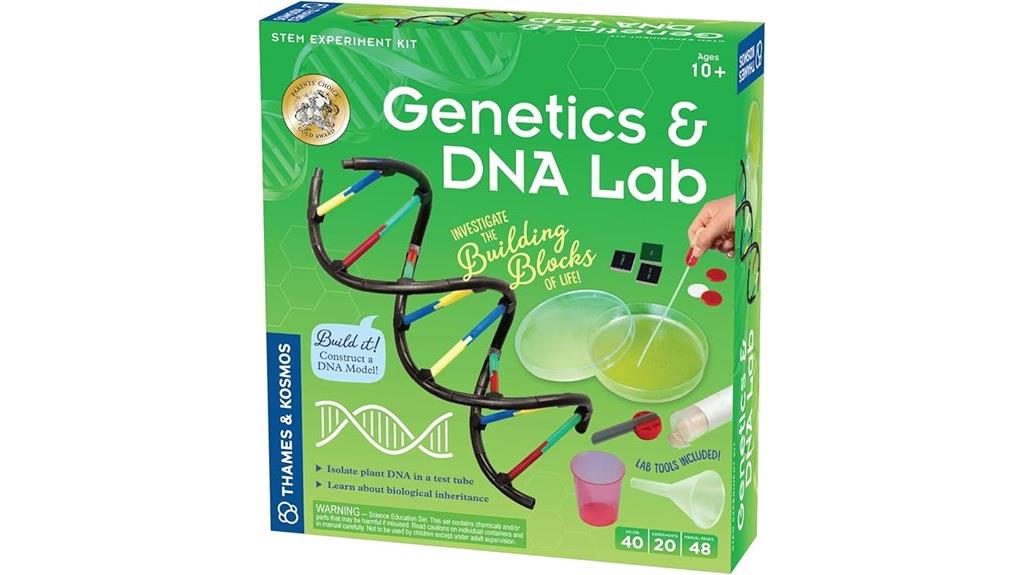
The Thames & Kosmos Genetics & DNA Lab, measuring 10 inches by 2.5 inches by 11 inches, is best suited for young science enthusiasts enthusiastic to explore genetics firsthand. It offers a compact design, making it easy to store and handle. Many kids find it exciting as a gift, but some users report quality issues—fragile DNA models, oversized test tubes, and ineffective experiments. The instructions can be unclear, and parts sometimes don’t work as expected. Despite its appeal, some feel the kit is overpriced for its limited functionality. Overall, it’s a fun introduction but may fall short for serious learners seeking reliable, hands-on DNA experiments.
Best For: young science enthusiasts and beginners interested in exploring genetics through a fun, introductory kit.
Pros:
- Compact and easy to store, making it suitable for small spaces and handling by children.
- Excites kids and makes a thoughtful gift for young learners interested in biology.
- Provides a hands-on introduction to genetics concepts in a simplified format.
Cons:
- Fragile components like the DNA model can be difficult to assemble and break easily.
- Some experiments may not work as intended due to design flaws or poor quality parts.
- Instructions may be unclear, and parts like test tubes and pipettes can be too large or narrow for proper use.
RELIANCER Molecular Model Kit, 444PCS Organic Chemistry Set
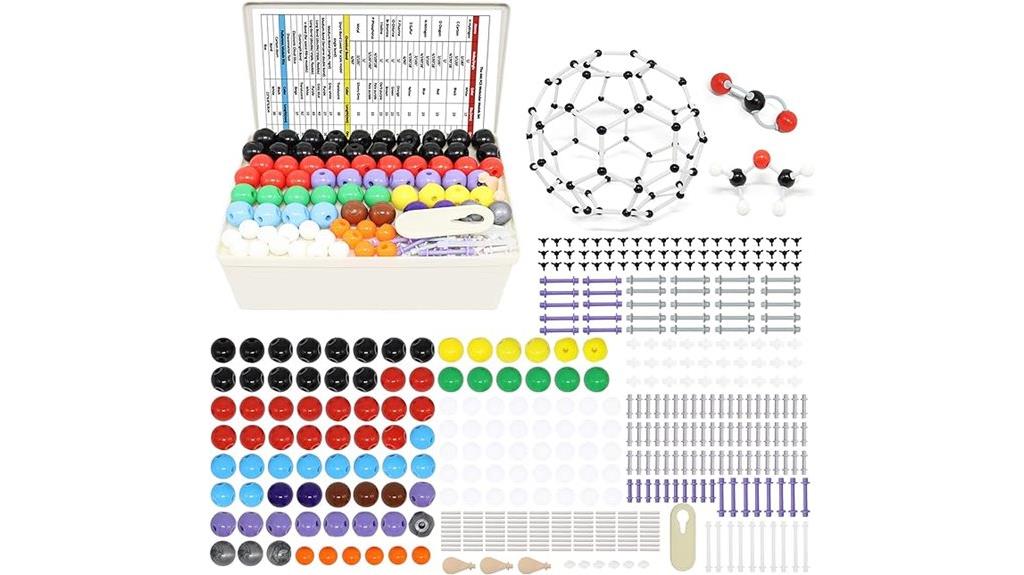
For educators and students seeking a versatile tool to visualize molecular structures, the RELIANCER Molecular Model Kit with 444 pieces stands out. It includes 136 atom pieces representing different elements, 154 bonds of various types, three electronic cloud slices, and a full fullerene model. Made from eco-friendly, non-toxic materials, the parts are durable and safe for repeated use. The color-coded system makes identifying atoms straightforward, enhancing understanding of molecular geometry and bonding. The set is ideal for teaching organic and inorganic chemistry, fostering hands-on learning. Its all-encompassing design helps students grasp complex concepts and encourages interactive exploration of molecular science.
Best For: educators, students, and STEM enthusiasts seeking a comprehensive, safe, and reusable molecular modeling kit to visualize and understand complex molecular structures.
Pros:
- Includes a wide variety of atom pieces, bonds, and special models like fullerenes for versatile learning.
- Made from eco-friendly, non-toxic materials ensuring safety and durability for repeated use.
- Color-coded components facilitate quick identification and enhance understanding of molecular shapes and bonding.
Cons:
- Limited piece count may restrict building very complex or large molecules.
- Lack of detailed instructions for constructing complex models like buckyballs can pose challenges.
- Packaging could be more secure to prevent loss or damage of small pieces during transport or storage.
Thames & Kosmos Kids First Biology Lab Introductory Microscope Kit

If you’re looking for an easy-to-use microscope that sparks curiosity in young learners, the Thames & Kosmos Kids First Biology Lab Introductory Microscope Kit is an excellent choice. Designed for kids aged 8-12, it features a durable plastic body and battery-powered LED lighting for clear viewing. With three objective lenses (4x, 10x, 40x) and a 15x ocular lens, it offers magnifications up to 600x. The kit includes slides, tools, and a detailed manual, enabling kids to explore onion cells, microorganisms, hair, and more. It’s simple to operate, engaging, and great for introducing basic microscopy and biological concepts in a fun, accessible way.
Best For: young children aged 8-12 who are beginning to explore biology and microscopy in a fun, accessible way.
Pros:
- Easy to use and suitable for beginners, especially children.
- Includes a variety of specimens and tools to facilitate hands-on learning.
- Affordable option that effectively introduces basic microscopy concepts.
Cons:
- Made primarily of plastic, which may feel less durable than metal.
- Limited focusing range and build quality of included tools.
- Not suitable for detailed or professional scientific research.
Stunning Chemistry Set with 100+ Experiments for Kids
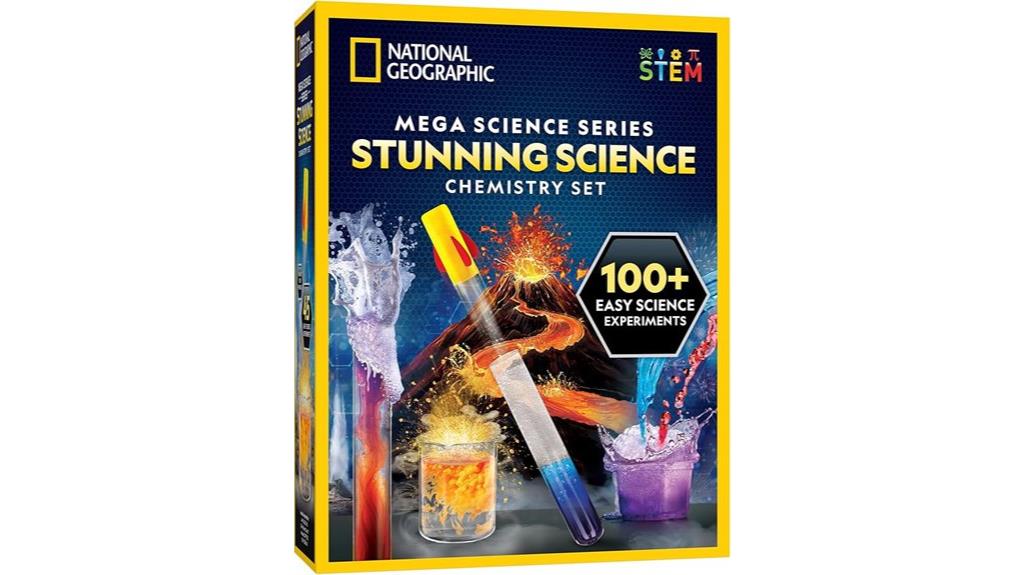
Kids aged 8 to 12 who love hands-on science will find the Stunning Chemistry Set with over 100 experiments especially engaging. This Amazon-exclusive kit includes exciting activities like launching rockets, building underwater volcanoes, and creating fizzy reactions. It provides all the materials needed for 15 core experiments and offers 85+ bonus experiments using household items. Designed to promote STEM skills, safety, and creativity, it’s perfect for homeschooling or classroom use. Rated 4.7 stars, users praise its quality and educational value. While some experiments are simpler, it’s an excellent way to spark curiosity, problem-solving, and a love of science in young learners.
Best For: kids aged 8 to 12 who are passionate about hands-on science, STEM learning, and creative experimentation.
Pros:
- Includes over 100 engaging experiments that promote STEM skills and creativity.
- Provides all necessary materials for core experiments plus additional activities using household items.
- Rated 4.7 stars with positive feedback on quality, safety, and educational value.
Cons:
- Small foil packets of chemicals are not resealable, requiring additional storage solutions.
- Assembly of certain components, like the volcano mold, can be challenging for some children.
- Experiments may be simpler than the images suggest, and instructions are only available in English.
LINKTOR Chemistry Molecular Model Kit (444 Pieces)
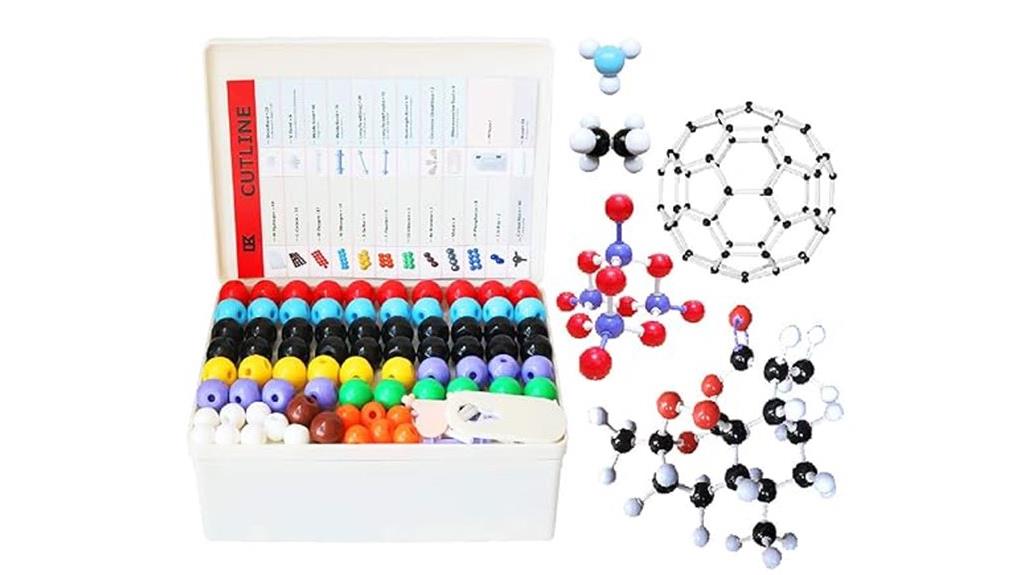
The LINKTOR Chemistry Molecular Model Kit (444 Pieces) stands out as an ideal choice for students and educators seeking an engaging, hands-on tool to understand complex molecular structures. With 136 atoms, 158 bonds, and parts for Carbon-60, it covers both basic and advanced chemistry concepts. The kit’s color-coded, realistic models help visualize molecular geometry, bonds, and stereochemistry in 3D, boosting spatial understanding. Its durable design, organized storage, and included guide make assembly straightforward. Users praise its quality, versatility, and ability to make learning chemistry interactive and fun. Despite some complexity for beginners, it’s a valuable resource for classroom, homeschooling, or personal exploration.
Best For: students, educators, and hobbyists of all ages seeking an interactive and realistic way to explore molecular structures and chemistry concepts.
Pros:
- Facilitates hands-on visualization of complex molecules and stereochemistry in 3D.
- Durable, well-organized, and easy to assemble with color-coded pieces for quick identification.
- Suitable for a wide range of educational levels from middle school to graduate studies.
Cons:
- May be challenging for beginners or young children to grasp initially without guided tutorials.
- Limited bonding options for more complex or non-tetrahedral molecules.
- Occasional missing pieces or packaging issues that can hinder assembly or completeness.
Science Kits for Kids, Chemistry Lab with 100 Experiments
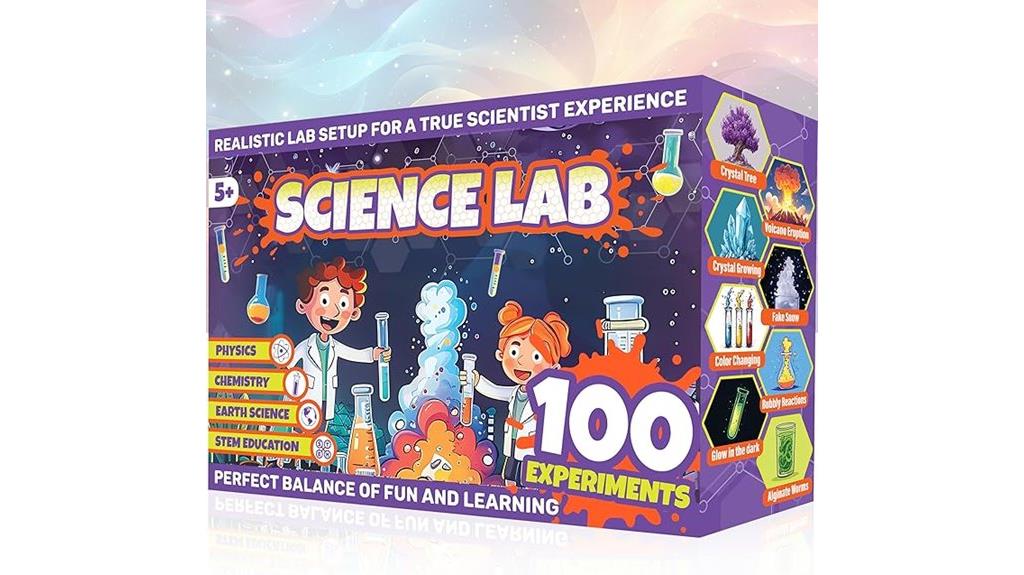
Biology and Chemistry Crossover Kits are an excellent choice for young science enthusiasts enthusiastic to explore multiple fields through hands-on experiments. The Chemistry Lab with 100 Experiments transforms any space into a real lab with sturdy tools, connectable dishes, organized stations, and an easy-to-clean tray. Kids wear a lab coat, goggles, and a name tag to feel like genuine scientists. With experiments covering chemistry, physics, and more, the kit features step-by-step manuals, video tutorials, and safety tips. Designed for kids aged 5 and up, it promotes curiosity, independent exploration, and safe practices, making science engaging and accessible for young learners.
Best For: young children aged 5 and up who are curious about science and eager to explore chemistry, physics, and other scientific fields through hands-on experiments.
Pros:
- Comprehensive set with 100 engaging experiments that promote learning and curiosity
- Includes quality tools, safety gear, and organized stations for a realistic lab experience
- Suitable for independent exploration with step-by-step guides, video tutorials, and safety instructions
Cons:
- Some experiments may require adult supervision, especially for younger children
- The set may have limited advanced experiments for older kids seeking more complex challenges
- The need for household staples like water, salt, and lemons might require additional preparation
National Geographic Mega Science Lab Kit for Kids

Designed for children aged 8 and up, the National Geographic Mega Science Lab Kit stands out as an excellent choice for young explorers enthusiastic to immerse themselves in both earth science and chemistry. With over 130 experiments, including 45 main activities and 85+ bonus projects, it offers a thorough hands-on experience. Kids can build volcanoes, grow crystals, dig fossils, and create water tornadoes, all while exploring real rock and mineral specimens. The kit’s detailed instructions and safety gear make experiments accessible and responsible. Recognized for quality and educational value, it’s a fantastic STEM gift that sparks curiosity and promotes independent scientific discovery.
Best For: young science enthusiasts aged 8 and up who are eager to explore earth science and chemistry through hands-on experiments.
Pros:
- Offers over 130 engaging experiments covering earth science, chemistry, and fun magic tricks.
- Includes real rock, mineral, and crystal specimens to foster curiosity about earth sciences.
- Designed with safety features like goggles and gloves, along with clear instructions suitable for children.
Cons:
- The kit is quite large and weighs nearly 6 pounds, which may be less convenient for portability.
- Some experiments may require adult supervision for safety or setup.
- The components, while high quality, may need careful handling to avoid messes or damage over time.
UNGLINGA Science Kits for Kids (260+ Experiments)

If you’re looking for an all-encompassing science kit that sparks curiosity across multiple disciplines, UNGLINGA Science Kits for Kids is an excellent choice—especially for children aged 5 and up who enjoy hands-on learning. With over 260 experiments, it covers chemistry, physics, magic, and more, encouraging creativity, problem-solving, and critical thinking. The kit includes high-quality, safe tools and detailed instructions, making it accessible for independent or supervised play. Kids love the variety, from erupting volcanoes to soap making, and parents appreciate its educational value. It’s a versatile, engaging way to explore science beyond typical projects, offering endless fun and learning opportunities.
Best For: children aged 5 and up who enjoy hands-on, educational science experiments that foster curiosity, creativity, and critical thinking.
Pros:
- Offers over 260 engaging and diverse experiments across multiple science disciplines.
- Includes high-quality, safe, and reusable materials with clear, easy-to-follow instructions.
- Suitable for independent play or supervised activities, making it versatile for different ages and skill levels.
Cons:
- Some experiments require waiting periods, such as drying time for bouncing balls or soap, which may test patience.
- Opening multiple packages for certain experiments can be inconvenient; organizing materials beforehand is recommended.
- Younger children may need adult assistance for safety and proper experiment execution.
Thames & Kosmos Chem C1000 Chemistry Set
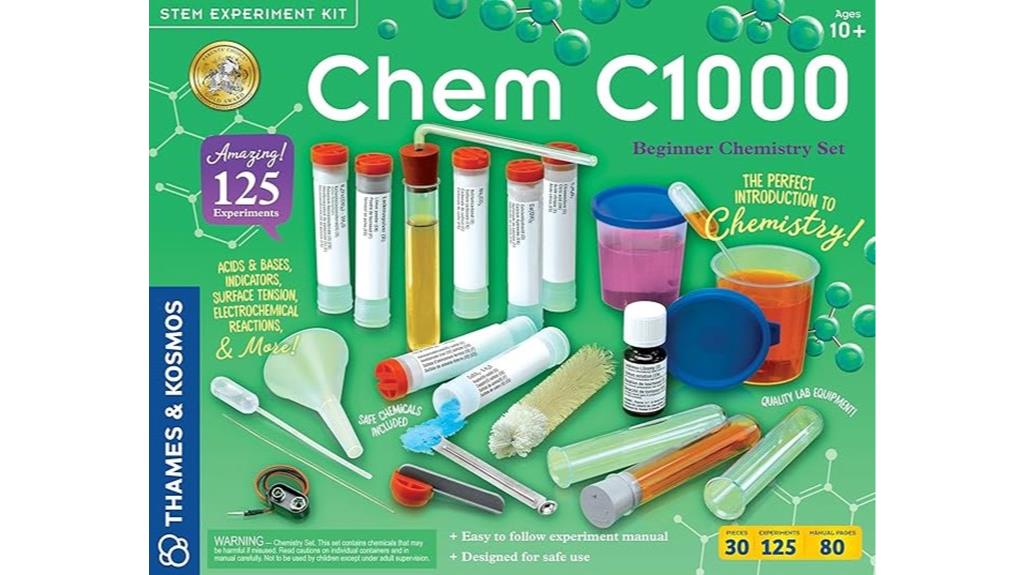
The Thames & Kosmos Chem C1000 Chemistry Set is an excellent choice for older children and beginners enthusiastic to explore chemistry through hands-on experiments. With 125 diverse activities, it covers concepts like indicators, invisible ink, chromatography, and physical properties of fluids. The set includes professional-grade lab tools and a detailed 80-page manual that guides safety and experimentation. While some experiments require additional household supplies, the kit’s engaging activities foster curiosity and understanding of chemical reactions. Recognized with a Parents’ Choice Gold Award, it’s perfect for curious young scientists eager to learn through exploration, patience, and observation.
Best For: curious older children and beginners eager to explore chemistry through hands-on experiments and detailed guidance.
Pros:
- Offers 125 diverse experiments covering a wide range of chemistry concepts.
- Includes professional-grade laboratory tools and a comprehensive 80-page manual.
- Recognized with a Parents’ Choice Gold Award for educational quality.
Cons:
- Requires additional household supplies not included in the kit, which can be inconvenient.
- Manual can be cluttered or overwhelming for younger children or beginners.
- Discontinued product, which may limit access to support or replacement parts.
OLD NOBBY Organic Chemistry 239 Piece Model Kit

The OLD NOBBY Organic Chemistry 239 Piece Model Kit stands out as an ideal choice for students and educators seeking a durable, high-quality tool to visualize complex molecular structures. Its color-coded atoms and flexible bonds make building and understanding molecules straightforward. The kit includes essential components like atoms, bonds, an instructional guide, and a molecular stencil, all housed in a well-organized storage box. Made from sturdy plastic, the parts fit snugly and withstand repeated use, supporting hands-on learning of organic chemistry concepts like stereochemistry and functional groups. Overall, it’s a reliable, practical set that enhances comprehension and engagement in chemistry education.
Best For: students, educators, and professionals seeking a durable, high-quality model kit to visualize and understand complex molecular structures in organic chemistry.
Pros:
- Color-coded atoms and flexible bonds enhance clarity and ease of assembly
- Durable, high-quality plastic parts withstand repeated use without breaking
- Organized storage box with compartments makes parts easy to find and keeps the kit neat
Cons:
- The box lid may require rubber bands for secure transport
- Packaging can become jumbled after opening, affecting organization
- Some users may find the set’s size limiting for very large or complex molecules
WILD ENVIRONMENTAL SCIENCE Medical Science STEM Kit (WES120XL)
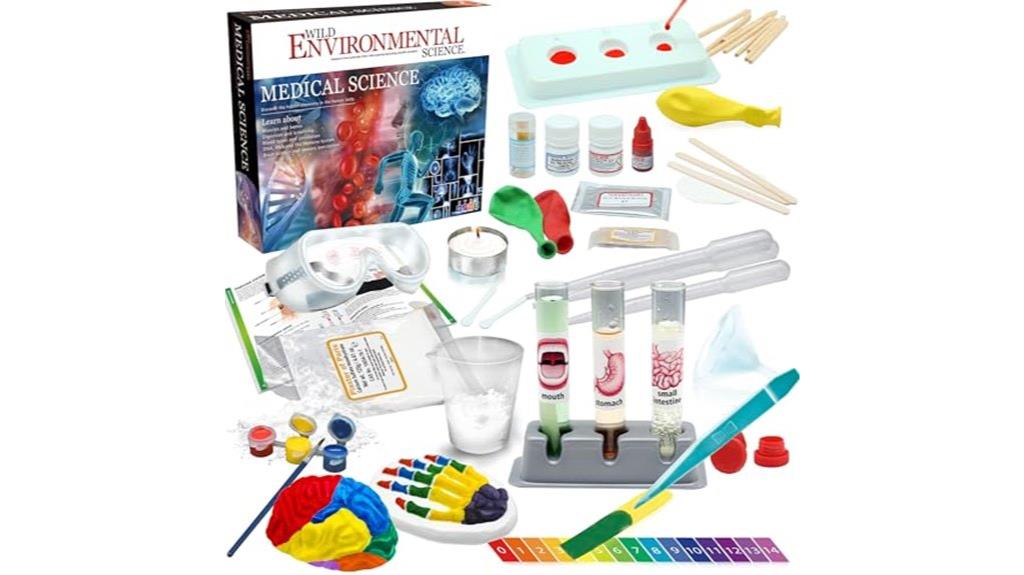
Designed for young science enthusiasts aged 8 and up, the WILD ENVIRONMENTAL SCIENCE Medical Science STEM Kit (WES120XL) offers over 50 hands-on activities that explore human body chemistry and biology. It includes lab tools, chemicals, and clear instructions to create reactions, observe enzymes, extract DNA, and build anatomical models. Kids can simulate blood types, study water properties, muscles, bones, and sensory perception. The kit encourages curiosity and pride by letting children explore real biological concepts through engaging experiments. Its well-designed content makes complex science accessible, inspiring future scientists while providing a fun, educational experience tailored for young learners.
Best For: young science enthusiasts aged 8 and up who are interested in hands-on biology and medical experiments.
Pros:
- Offers over 50 engaging, hands-on activities that make complex biological concepts accessible.
- Includes high-quality lab tools, chemicals, and detailed, easy-to-follow instructions.
- Encourages curiosity, scientific pride, and learning through real product creation and exploration.
Cons:
- The box size and contents may feel limited for older children or more advanced learners.
- Additional purchases might be required to fully explore some experiments or expand the experience.
- Some users find the overall value less satisfying given the price and content quantity.
Factors to Consider When Choosing Biology and Chemistry Crossover Kits (for Young Scientists)
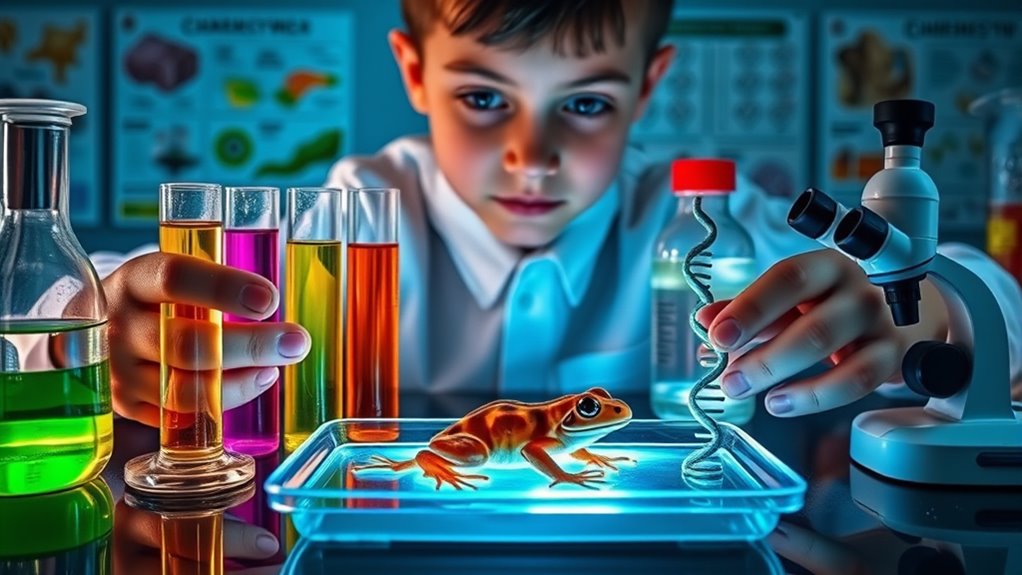
When selecting a biology and chemistry crossover kit for young scientists, I consider factors like age appropriateness and safety features to guarantee the kit is suitable and secure. I also look at the educational content and variety of experiments to keep learning engaging and diverse. Ultimately, material quality is vital for durability and a positive hands-on experience.
Age Appropriateness
Choosing the right biology and chemistry crossover kits depends heavily on the child’s age and developmental stage. It’s crucial to select a kit with an age recommendation that matches their abilities, whether it’s 4+ for beginners or 12+ for more advanced learners. The complexity of experiments should align with their cognitive skills, offering simple, step-by-step activities for younger children and more challenging projects for older kids. Additionally, make sure the educational content and themes are age-appropriate, keeping kids engaged without causing frustration or boredom. The kit should also include properly sized tools and components that are safe and manageable for small hands, minimizing risks like choking hazards or misuse. Matching the kit to their developmental level promotes a safe, enjoyable, and educational experience.
Safety Features
Safety features are essential factors to consider when selecting biology and chemistry crossover kits for young scientists, as they help guarantee a secure and enjoyable learning experience. Make sure the kit includes protective gear like safety goggles and gloves to prevent injuries. Check that all chemicals and materials are non-toxic, food-safe, and meet safety standards for children’s products. Clear safety instructions and warnings are vital for teaching proper handling and emergency procedures. Look for spill-proof containers or sealed compartments to reduce mess and accidental exposure. Additionally, verify if the kit has safety certifications or endorsements from reputable organizations, ensuring it adheres to safety standards. Prioritizing these features helps create a safe environment where young learners can explore science confidently.
Educational Content
Ensuring safety features are in place is just the first step; the educational content included in biology and chemistry crossover kits greatly influences how well young scientists grasp and connect concepts. Look for kits that provide thorough explanations of biological and chemical ideas to foster an integrated understanding. Clear, step-by-step experiment instructions are essential, especially those that link biological processes with chemical reactions, making connections tangible. The educational material should cover foundational topics like cell structure, molecular bonding, and chemical reactions in living organisms. Including real-world applications, such as DNA analysis or enzyme activity demonstrations, helps illustrate the crossover between sciences. Lastly, guarantee the content is age-appropriate, engaging, and scientifically accurate to support ongoing curiosity and learning.
Experiment Variety
A wide variety of experiments in a biology and chemistry crossover kit opens up many opportunities for young scientists to explore different scientific concepts. With diverse activities like DNA extraction, chemical color changes, and microscopy, kids stay engaged and motivated. This assortment supports different learning styles and keeps curiosity high. Kits that include both simple and complex experiments help children build foundational skills before progressing to more advanced topics, such as molecular structures or environmental interactions. Having multiple experiments also broadens their understanding of biology and chemistry, encouraging interdisciplinary thinking. Additionally, more options mean more chances for hands-on practice, critical thinking, and testing hypotheses, making the learning process more dynamic and enriching. This variety is key to fostering a comprehensive scientific education.
Material Quality
Choosing high-quality materials for biology and chemistry crossover kits is essential because durable, well-made components provide a safer and more enjoyable learning experience. When I look for a kit, I prioritize items made from non-toxic, eco-friendly plastics that reduce health risks and environmental impact. Precise manufacturing standards matter because they ensure parts are free of sharp edges and loose pieces that could cause injury or frustration. Good material quality also guarantees accurate representations of molecules, biological specimens, and chemical reactions, which is crucial for effective learning. Additionally, sturdy construction of tools and models means the kit will last through multiple experiments, maintaining its educational value over time. Overall, investing in high-quality materials makes the entire scientific exploration safer, more reliable, and more engaging for young learners.
Frequently Asked Questions
What Safety Precautions Are Essential for Young Children Using These Kits?
When kids use these kits, safety is my top priority. I always supervise closely, guarantee they wear protective gear like goggles and gloves, and teach them proper handling of chemicals. I also keep all materials away from their mouths and eyes, and make sure the workspace is clean and well-ventilated. By following these precautions, I help create a safe environment where young scientists can explore and learn confidently.
How Do These Kits Support STEM Education Development?
These kits play a vital role in supporting STEM education by engaging young learners with hands-on experiments that spark curiosity. I’ve seen how they promote critical thinking, problem-solving, and a love for science early on. By making complex concepts accessible and fun, these kits inspire kids to explore biology and chemistry together, laying a strong foundation for future scientific pursuits. I truly believe they’re essential tools in inspiring the next generation of innovators.
Are Replacement Parts or Extra Components Available for These Kits?
You’re wondering if replacement parts or extra components are available for these kits. I’ve found that most reputable kits include options for replacements or additional parts, ensuring extended use and ongoing learning. Companies often offer these through their websites or customer service. I recommend checking the specific brand’s support page or contacting their customer service directly to get the exact parts you need, making sure your young scientist can keep exploring without interruptions.
Can These Kits Be Used Independently or Need Adult Supervision?
Imagine stepping into a colorful laboratory where curiosity sparks like tiny stars. I believe these kits are designed to inspire young minds, but I’d recommend adult supervision for safety and guidance. While some activities are straightforward, having an adult nearby helps guarantee proper use, understanding, and safety. Think of it as a team effort—kids explore, and adults help steer the adventure, making science both fun and secure.
What Age Range Is Most Appropriate for Each Kit’s Complexity?
When considering age-appropriate kits, I recommend paying close attention to the complexity level. For younger kids, around ages 8-10, look for simpler experiments that focus on basic concepts. Older children, say 11-14, can handle more detailed activities involving precise measurements and chemical reactions. I always suggest checking the manufacturer’s age recommendations to guarantee safety and engagement, making science fun and educational at the right developmental stage.
Conclusion
Based on what I’ve researched, I believe that introducing young scientists to biology and chemistry through these kits can spark curiosity and critical thinking. While some might think hands-on experiments don’t teach real science, I’ve found that testing theories firsthand can actually deepen understanding. So, I encourage you to choose a kit that challenges your child’s curiosity—because when they question and explore, they’re truly learning how science works in the real world.

